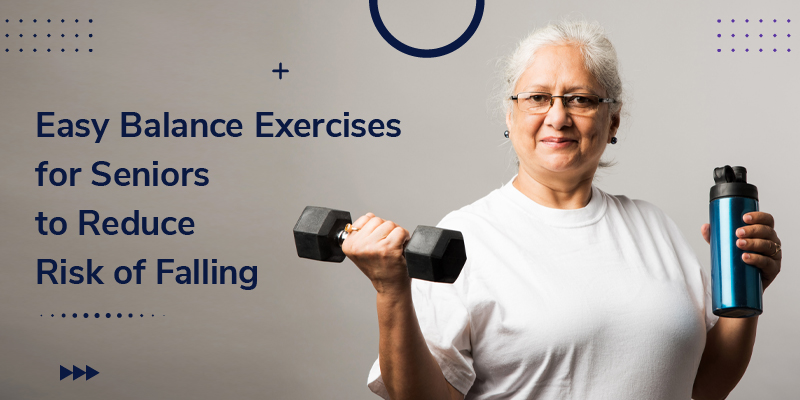
Stay Steady & Age Gracefully- Balance Exercises for Seniors
Nearly one in four people aged 65 and above experience a fall annually, as reported by the CDC. One in five falls results in a catastrophic injury, such as a broken hip or a brain injury, and the chance of falling again doubles after the first fall. Visual impairment, sensory deficiencies, medications, and co-existing conditions like high blood pressure and diabetes can all contribute to impaired balance.
However, even a little exercise routine can make a significant difference in your balance. In addition to lowering your chance of falling, dementia, blood pressure, as well as other health problems can be avoided by engaging in balance exercises.
Evaluation Of Potential Fall Risks
In order to avoid future falls, it is important to first determine how high your risk of falling is. According to the Centers for Disease Control (CDC), there are three questions you should ask yourself to gauge your individual vulnerability:
- Did you experience a fall last year?
- Do you feel shaky when you're on your feet?
- Are you afraid of falling?
If you answered “yes” for any of the above, your chances of falling are also high. However, with some effort and the appropriate fall-prevention exercises, you may strengthen your whole body and improve your balance to the extent that your chance of falling decreases as you age.
Expert Recommended Balance Exercises For Seniors
When you get older, it becomes increasingly important to engage in consistent physical activity, as loss of strength can cause frequent falls. To strengthen your back, glutes, and legs and enhance your balance, try out these exercises for balancing and preventing falls.
Sit - ups: Sit upright in a chair without back support and then stand up. To change from a sitting position to a standing position, lean forward and use your arms to push up. Bend your knees and hips as you carefully lower yourself into the chair from a standing position by going back again for arm rests. This exercise enhances your back leg muscles, improving your posture and balance. The recommended routine consists of 10 sets performed 3-4 times daily and five days a week.
Standing marches- It is a spine-supporting core-strengthening workout that relaxes muscles. Keep your feet shoulder-width apart and your body upright. Raise one leg until the knee forms a right angle with the ground, pause, then lower the leg slowly. After completing a set of 20, switch legs and repeat.
Standing heel pushes - Stand upright with your hands on a chair or countertop if needed. Lift your heels slowly off the floor, hold for a second, and repeat the exercise slowly. Keep your head up and your spine straight; avoid rolling your ankles inward or outward. Heel raises are great for improving your balance since they engage your calves and ankles.
Standing on one leg - By repeatedly standing on one foot, or "leg," you may work on your balance and core strength just like you would with a pair of legs. Keep your feet shoulder-width apart while standing. Stand with one foot raised a couple of inches off the floor and maintain this position for 10 to 15 seconds. When you've completed five repetitions with one foot, switch to the other foot and repeat.
Heel-to-toe walk- In this exercise you will need to place your left foot ahead of the right foot such that your heel nearly touches the toes in a straight line from your hips. For the next 20 steps, you must advance with your opposite foot. After five rounds, turn around and do it again.
Sideways walking -The ‘sideways walking' exercise is a simple and effective approach to get in shape. Taking a few lateral steps with your legs makes you more stable. Keep your feet hip-width apart, and kneel down just a bit by bending your knees. Put your right foot in front of the other and slowly stride to the right. Place your left foot next to your right one, and then take a stride to the right with your right. Do a 10-step countdown and a 180-degree turn. To continue, take 10 steps to the left, and then 10 steps to the right.
Ankle movements- Flex your ankles and erect your posture. Place your weight (or centre of gravity) on your left foot. To shift your weight to the opposite foot, raise the right heel and then the toes. You should bring your right knee up as far as it feels good. There's a natural tendency for the shoulders and head to turn forward when you raise the knee. Hold your head up high. Repeatedly point and flex the right ankle. The next step is to spin the foot in both directions. Step down with your right foot. Move to the reverse side and do the same.
However, if you find that you require help, you should try to balance yourself by standing against a wall or having something nearby that you can grab onto until you are able to perform it without assistance.
Some fall prevention strategies for seniors
Although studies reveal an increased risk of falls for people over 65, there are other characteristics that can help elders avoid injury. Taking charge of your health as you age can reduce the likelihood of falls, ease discomfort, and improve your overall quality of life.
- Make sure everything you need is within easy access. All mobility aids, such as walkers, wheelchairs, and canes, fall under this category.
- Keep the halls and hall closets in your house uncluttered. Cleaning up the house and putting away potential trip hazards like cords, boxes, and toys is a great place to start.
- Keep your house well-lit, especially the way from and to the bathroom at night by using nightlights.
- Be sure you put on a pair of comfortable, well-maintained shoes. It's best to wear shoes that will support your feet, rather than flip-flops.
- Make use of available handrails and grab bars. Handrails on all staircases and in showers are great for those who need a little more support.
- Get rid of the scatter rugs since they pose a fall risk.
- Bifocals can make it harder to evaluate spacing. That's why it's smart to always have a backup set of glasses handy.
- Medications for chronic conditions or old injuries might cause sleepiness and fainting in certain elderly people. If you have trouble keeping your balance, you should see a doctor.
Also Read: Loss of Appetite in the Elderly- Causes and Solutions
REAN HealthGuru- Aiding Seniors to Maintain Health & Avoid Falls
The REAN HealthGuru available is a game-changer for health management. It allows you to set and follow an ideal exercise routine to maintain good mental and physical health. It also lowers the likelihood of injury by a regimen of balance exercises. It is time for you to regain command of your life. Get in touch with the REAN HealthGuru team today to start your journey to better health!
The fear of becoming dependent on others due to a severe injury is added to the fact that falls are a leading cause of death among the old. However, you can lower your risk of injury from falls by working on your balance and strength. Maintaining your equilibrium is a skill that can be improved by including balancing exercises in your regular routine. Maintaining your house free of falling risks and engaging in regular physical activity can significantly reduce the likelihood of injury from falls. Try our REAN HealthGuru expert-recommended balance exercises for seniors listed out in this blog to reduce the risk of falling. Our tailored exercises will help improve balance and stability, giving you the confidence to move around with ease. Join us today and take control of your health!
Nearly one in four people aged 65 and above experience a fall annually, as reported by the CDC. One in five falls results in a catastrophic injury, such as a broken hip or a brain injury, and the chance of falling again doubles after the first fall. Visual impairment, sensory deficiencies, medications, and co-existing conditions like high blood pressure and diabetes can all contribute to impaired balance.
However, even a little exercise routine can make a significant difference in your balance. In addition to lowering your chance of falling, dementia, blood pressure, as well as other health problems can be avoided by engaging in balance exercises.
Evaluation Of Potential Fall Risks
In order to avoid future falls, it is important to first determine how high your risk of falling is. According to the Centers for Disease Control (CDC), there are three questions you should ask yourself to gauge your individual vulnerability:
- Did you experience a fall last year?
- Do you feel shaky when you're on your feet?
- Are you afraid of falling?
If you answered “yes” for any of the above, your chances of falling are also high. However, with some effort and the appropriate fall-prevention exercises, you may strengthen your whole body and improve your balance to the extent that your chance of falling decreases as you age.
Expert Recommended Balance Exercises For Seniors
When you get older, it becomes increasingly important to engage in consistent physical activity, as loss of strength can cause frequent falls. To strengthen your back, glutes, and legs and enhance your balance, try out these exercises for balancing and preventing falls.
Sit - ups: Sit upright in a chair without back support and then stand up. To change from a sitting position to a standing position, lean forward and use your arms to push up. Bend your knees and hips as you carefully lower yourself into the chair from a standing position by going back again for arm rests. This exercise enhances your back leg muscles, improving your posture and balance. The recommended routine consists of 10 sets performed 3-4 times daily and five days a week.
Standing marches- It is a spine-supporting core-strengthening workout that relaxes muscles. Keep your feet shoulder-width apart and your body upright. Raise one leg until the knee forms a right angle with the ground, pause, then lower the leg slowly. After completing a set of 20, switch legs and repeat.
Standing heel pushes - Stand upright with your hands on a chair or countertop if needed. Lift your heels slowly off the floor, hold for a second, and repeat the exercise slowly. Keep your head up and your spine straight; avoid rolling your ankles inward or outward. Heel raises are great for improving your balance since they engage your calves and ankles.
Standing on one leg - By repeatedly standing on one foot, or "leg," you may work on your balance and core strength just like you would with a pair of legs. Keep your feet shoulder-width apart while standing. Stand with one foot raised a couple of inches off the floor and maintain this position for 10 to 15 seconds. When you've completed five repetitions with one foot, switch to the other foot and repeat.
Heel-to-toe walk- In this exercise you will need to place your left foot ahead of the right foot such that your heel nearly touches the toes in a straight line from your hips. For the next 20 steps, you must advance with your opposite foot. After five rounds, turn around and do it again.
Sideways walking -The ‘sideways walking' exercise is a simple and effective approach to get in shape. Taking a few lateral steps with your legs makes you more stable. Keep your feet hip-width apart, and kneel down just a bit by bending your knees. Put your right foot in front of the other and slowly stride to the right. Place your left foot next to your right one, and then take a stride to the right with your right. Do a 10-step countdown and a 180-degree turn. To continue, take 10 steps to the left, and then 10 steps to the right.
Ankle movements- Flex your ankles and erect your posture. Place your weight (or centre of gravity) on your left foot. To shift your weight to the opposite foot, raise the right heel and then the toes. You should bring your right knee up as far as it feels good. There's a natural tendency for the shoulders and head to turn forward when you raise the knee. Hold your head up high. Repeatedly point and flex the right ankle. The next step is to spin the foot in both directions. Step down with your right foot. Move to the reverse side and do the same.
However, if you find that you require help, you should try to balance yourself by standing against a wall or having something nearby that you can grab onto until you are able to perform it without assistance.
Some fall prevention strategies for seniors
Although studies reveal an increased risk of falls for people over 65, there are other characteristics that can help elders avoid injury. Taking charge of your health as you age can reduce the likelihood of falls, ease discomfort, and improve your overall quality of life.
- Make sure everything you need is within easy access. All mobility aids, such as walkers, wheelchairs, and canes, fall under this category.
- Keep the halls and hall closets in your house uncluttered. Cleaning up the house and putting away potential trip hazards like cords, boxes, and toys is a great place to start.
- Keep your house well-lit, especially the way from and to the bathroom at night by using nightlights.
- Be sure you put on a pair of comfortable, well-maintained shoes. It's best to wear shoes that will support your feet, rather than flip-flops.
- Make use of available handrails and grab bars. Handrails on all staircases and in showers are great for those who need a little more support.
- Get rid of the scatter rugs since they pose a fall risk.
- Bifocals can make it harder to evaluate spacing. That's why it's smart to always have a backup set of glasses handy.
- Medications for chronic conditions or old injuries might cause sleepiness and fainting in certain elderly people. If you have trouble keeping your balance, you should see a doctor.
Also Read: Loss of Appetite in the Elderly- Causes and Solutions
REAN HealthGuru- Aiding Seniors to Maintain Health & Avoid Falls
The REAN HealthGuru available is a game-changer for health management. It allows you to set and follow an ideal exercise routine to maintain good mental and physical health. It also lowers the likelihood of injury by a regimen of balance exercises. It is time for you to regain command of your life. Get in touch with the REAN HealthGuru team today to start your journey to better health!
The fear of becoming dependent on others due to a severe injury is added to the fact that falls are a leading cause of death among the old. However, you can lower your risk of injury from falls by working on your balance and strength. Maintaining your equilibrium is a skill that can be improved by including balancing exercises in your regular routine. Maintaining your house free of falling risks and engaging in regular physical activity can significantly reduce the likelihood of injury from falls. Try our REAN HealthGuru expert-recommended balance exercises for seniors listed out in this blog to reduce the risk of falling. Our tailored exercises will help improve balance and stability, giving you the confidence to move around with ease. Join us today and take control of your health!



